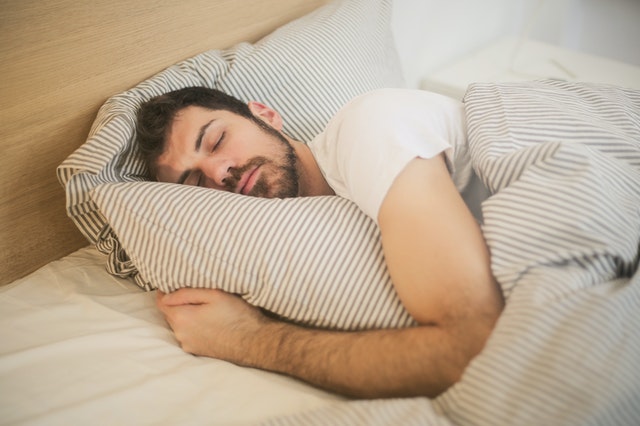 For many people, getting a sufficient amount of quality, restorative sleep can be a challenge. Most Americans average fewer hours of sleep per night than is recommended by experts for optimum health and physical performance.
For many people, getting a sufficient amount of quality, restorative sleep can be a challenge. Most Americans average fewer hours of sleep per night than is recommended by experts for optimum health and physical performance.
For neuropathic and chronic pain patients, the struggle to attain sufficient sleep levels consistently can often be even more consequential.
Pain-induced sleep deprivation can have a negative impact on the healing process, particularly for patients who were already not getting enough rest before their medical event. Lack of sleep has been directly linked to an increase in discomfort, as our unrested bodies can suddenly become more acutely aware of pain signals that our rested selves could more easily ignore.
Additionally, elevated physical, mental, and emotional fatigue can lower tolerance levels, directly increasing pain acuity. A study conducted by the University of Washington on healthy, middle-aged women revealed that disrupted sleep reduced pain thresholds, increased dermal sensitivities, and intensified overall discomfort benchmarks.
Breaking the Cycle of Sleeplessness and Chronic Pain
At Florida Pain Relief Centers, our team of board-certified pain management specialists recognizes the importance of getting enough deep, REM sleep to repair and restore our bodies. And we are aware that physical discomfort often disrupts normal rest patterns. Both chronic and acute aches can trigger heightened microarousals, or changes in our sleep state to a less restful stage, posing a direct and potentially significant sleep intrusion.
As a result, many of our patients find themselves simultaneously managing both the discomfort of their condition as well as various degrees of insomnia throughout treatment.
Assessing Your Sleep Hygiene
The medical professionals at the Florida Pain Relief Centers recognize that getting enough rest has a significant impact on the body and mind throughout the healing process. We believe that it is possible to “re-learn” how to sleep with chronic pain., and we consult with patients at every care phase to discuss various methods that may help increase the total hours of quality sleep attained each night.
The first step in re-calibrating your sleeping patterns is to prioritize rest as a vital component in your wellness journey.
Many people don’t realize the importance of good “sleep hygiene,” or the activities and things we do during the day that can directly disrupt a night of sleep. It’s important to take careful inventory of your current sleep hygiene and be ready to adjust your existing habits, variables, and routines for better nightly results.
Here are some considerations for your sleep hygiene list:
Light Levels
Exposure to light helps regulate our bodies, allowing us to discern when we should be awake and when we should be at rest. Melatonin, the hormone that promotes sleep, is triggered (as well as inhibited) based on light levels. It’s critical to increase sunlight exposure throughout the day and decrease artificial light at night to promote the release of melatonin in the body.
Diet
Nutritional intake can help or hinder our sleeping patterns. Heavy meals and foods with high fat and sugar content, especially close to bedtime, can increase the risk of insomnia. Avoiding caffeine, alcohol, and even chocolate at least 4 hours before bed can also help prepare your body for slumber.
Physical Activity
It’s no secret that intense daytime activity can promote deep sleep in the night hours. However, many chronic pain patients have physical limitations that restrict movement. Many pain management experts work with patients to develop a plan for low impact activities and/or stretching that encourage longer periods of restfulness without exacerbating their conditions or hindering treatment progression.
Nighttime Routines
Once you’ve analyzed your daytime habits, it’s essential to also evaluate some of the nighttime factors that may influence how well and how long you sleep each night. Some bedtime routine considerations may include:
Room Temperature
While everyone’s body is different, most people find that they sleep better in a cooler room. Experiment with various temperatures ranging anywhere from 60-75 degrees to determine the best rest environment for you.
Adjust Pillow Position
The right pillow and pillow adjustment can improve the quality of sleep for chronic pain patients. Based on your condition and specific health profile, your pain doctor can suggest the best sleeping positions and pillow adjustments to help increase nighttime relief.
Commit to a Consistent Daily Wake-Up Time
While you may not always be in control of when you fall asleep, you can take charge of when you wake up. Setting a consistent daily wake up time establishes a benchmark for your body’s circadian rhythms, so it understands what’s expected of it every day at the same time.
Additionally, a scheduled wake up time also helps you avoid oversleeping. While “catching up” on sleep may offer a temporary reprieve from fatigue, it can eventually lead to poor, restless, shallow sleep that ultimately aggravates your pain thresholds.
You Can Rest Easier When You Have Less Pain
 Florida Pain Relief Centers offers chronic pain patients access to a diverse range of effective, non-invasive treatments and therapies. We prioritize the care experience and patient comfort to increase function and enrich overall quality of life.
Florida Pain Relief Centers offers chronic pain patients access to a diverse range of effective, non-invasive treatments and therapies. We prioritize the care experience and patient comfort to increase function and enrich overall quality of life.
To consult with one of our board-certified pain management physicians, call Florida Pain Relief Centers at 800-215-0029. Or, you can click the button below to schedule a consultation online for one of our clinics.

